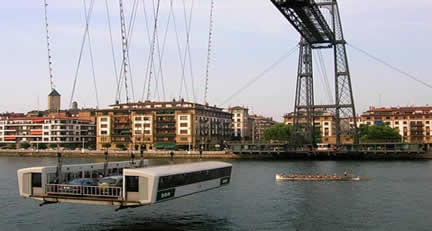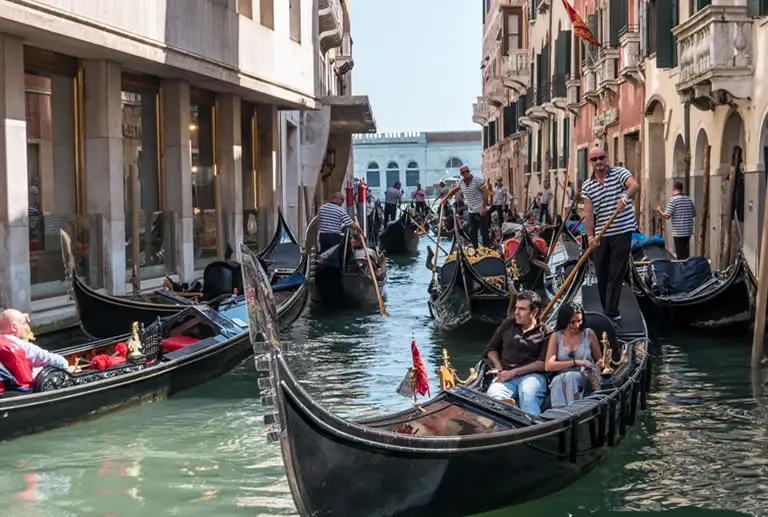Before we delve further into the subject gondolas and gondola boats let’s look at what this boat is.
What is a gondola?
The most well known gondola is a Venetian flat-bottomed boat that ‘s propelled and steered by a single oar.
Suspended cars on ski lifts, fairground Ferris wheels and Zeppelin airships are also called gondolas.
Some free-standing retail display units, open-top railway freight carriages and the high-rise platform used by window cleaners are called gondolas.
Contents
The 7 Different Types Of Gondola
At Flatbottomboatworld.com we’re going to reveal some details about the gondola boat, the distinctive traditional Venetian vessel that has a flat-bottomed hull before venturing into the lesser known types of gondolas that you may not even know exist.
Gondolas are not always boats!
You see the term ‘gondola’ is also used to refer to other forms of transportation as we will highlight later.
The Gondola Boat
The traditional gondola boat =, seen on the waterways of Venice, is the most well known type of gondola.
A Venetian gondola is an iconic flat bottomed boat in Venice that has raised sections at the bow and stern.
Traditionally a gondola is handmade from wood with intricate metal adornments attached.
When finished, a newly built gondola weighs around 1,500lbs (700 kg).
Eight different varieties of wood are used in the construction and it is assembled from 280 individual pieces.
The cost to build a modern gondola would be between 20,000 – 50,000 Euros (approximately $22,500 – $56,800).
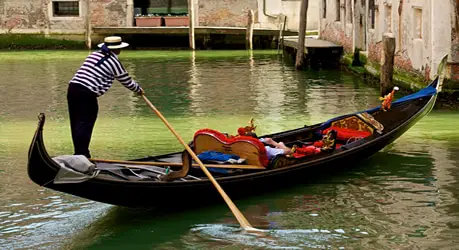
The history of the gondola boat starts in Venice
Some say the gondola dates back to 697 AD although the earliest documented reference only dates to 1094 AD.
Needless to say the gondola is steeped in history and over time some dramatic changes came about to alter the design that has lead to the gondola that we know today.
By the middle of the 16th century, gondolas had become a sign of wealth in Venice and owners would decorate their boats so ostentatiously that in 1562 the ‘serenissima’ (Venetian government) set new laws declaring all gondolas had to be painted black.
During 1800, the sumptuary laws (laws restraining luxury or extravagance) dictated the physical characteristics of gondolas resulting in their similar appearance to each other.
Not only did all working gondolas have to be black in color but all gondolas had to be manufactured to exacting dimensions.
It is still the customary to paint modern working gondolas black today.
Side-stepping these local customs are rowing clubs who will usually paint their gondolas in their club colors.
In modern times government owned gondolas are also painted in colors other than black.
All modern gondolas are exactly 35ft 6 ins long (10.87 m) by 4 ft 6 ins wide (1.42 m) as decreed by early laws.
Another quirky anomaly to their construction sees that the left side of the boat is 10 inches (24 cm) longer than the right side.
The purpose of this oddity is that the design is thought to counterbalance the rowing action of the gondolier so the boat is moved in a straight line.
Unique to gondola boats are some very interesting features such as:
- Felze
- Fero da Prova
- Forcola
Let’s take a look at these features more closely.
Venetian gondola boat design
The iconic gondola style is the result of changes made throughout the centuries, whittled down, tried and tested and finally defined by law, the gondola shape, size and color are now set in stone.
Be aware though that not all Venetian rowing boats are gondolas. See sandola for more information.
Gondola Felze – the removable cabin of a gondola boat
The ‘felze’ or cabin of a gondola was a removable wooden cover that protected passengers from foul weather in winter and the searing sun in summer.
The passengers could look through louvered slats built into the sides of the felze that gave rise to the term ‘Venetian Blinds’ which are associated today with modern window shutters.
Venice was, and still is, renowned for love and romance and the felze may have played a small part in creating the backstory.
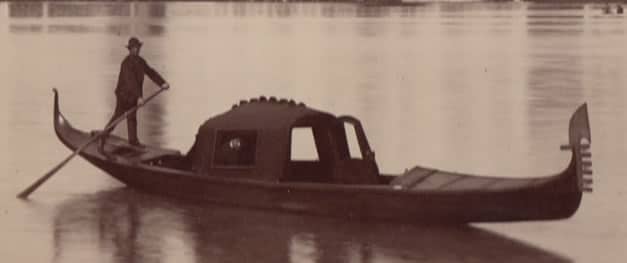
Venice was also known as the city of luxury with inhabitants and visitors indulging in opulent parties and seductiveness and the felze provided a perfect cover for clandestine meetings, alluring a furtive culture of seduction and intimacy.
This once highly decorated cabin with carved walnut griffin heads, stylised flowers and an opulent interior of satin fell by the wayside in favor of an open top.
A decision driven mostly by the increasing number of tourists who preferred to see more of the city than to be covered by a felze.
Gondola Fero da Prova – the unique front end of a gondola boat
At the bow of a gondola is a very unique ornamental design called a ‘fero da prova’, meaning ‘Iron’.
The shape of the ‘fero’ is a very distinctive comb-like design that symbolizes specific areas of Venice, or so it is widely believed!
The fero da prova is an ornate figurehead finial that is fixed to the prow of the gondola and is primarily made from iron, although other materials are also used.
The iron, (about 22 lbs / 10 kg) also acts as a counter-balance to the gondolier at the rear of the boat and helps keep the hull flat with the water.
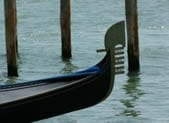 Sometimes called ‘the comb’ or ‘bow iron’ the fero is designed to represent specific areas of Venice.
Sometimes called ‘the comb’ or ‘bow iron’ the fero is designed to represent specific areas of Venice.
The overall curved shape denotes the Grand Canal while the six forward facing ‘pettini’ (teeth or prongs) representing the six districts in which Venice is divided, Cannaregio, Castello, Dorsoduro, San Marco, San Polo and Santa Croce.
The rearward pointing tooth symbolises Giudecca Island.
It’s generally accepted that the curved top of the bow iron represents the ‘hat of the Doge’ (Duke of Venice) but some alternative interpretations suggest a lily, a Venetian halberd (a combined spear and battle-axe) or the sea.
The shape between the first finger and Doge represents the Basin of San Marco and the arched line represents the Rialto Bridge.
Three further adornments are included between the fingers to show the importance of the three main islands, Murano, Burano and Torcello.
A later discovery however may suggest that the fero da prova is of ancient Chinese descent, used as a ceremonial spear in rituals.
The gondola oar and forcola design
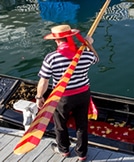 It’s a misconception that a gondola driver, or gondolier, uses a pole to propel the boat. The Venetian canals are simply too deep to ‘punt’ gondolas with a pole.
It’s a misconception that a gondola driver, or gondolier, uses a pole to propel the boat. The Venetian canals are simply too deep to ‘punt’ gondolas with a pole.
A gondola does not use a pole but instead using one gondola oar.
The gondola rowing oar is used in conjunction with a forcola, which allows the boat to be rowed in a sculling manner.
The forcola is an strangely shaped oarlock, or more precisely, an oar post.
The gondolier can use the oar in ways that provide a variety of fulcrum positions from which to row and control the motion and direction of the boat.
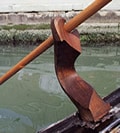
The multi-faceted forcola is handmade by a ‘rimèri’ or skilled carpenter and is a masterpiece of craftsmanship.
How does a gondola work?
The oar can be positioned in various ways so that the gondolier can perform other rowing functions, such reversing and stopping the boat.
This also allows the oar to be maneuvered in such a way that it can perform other rowing functions, such as steering which is usually reserved for a rudder.
Venice in the 1600’s would have seen as many as 10,000 gondolas traversing the 170 canals.
However, gondolas are as few as 400 today resulting in a drastic decline in the skills and the craftsmanship employed in creating a gondola.
The role of a gondola boat driver – the traditional male gondolier
A gondolier is the person who rows a gondola in and around the canals of Venice and it is considered a very prestigious and privileged position to hold.
The most common route to becoming a gondolier is through the unashamedly nepotistic (being kept in the family) tradition of passing the trade from father to son and retaining the traditional values.
Keeping the trade in the family also keeps the very valuable gondola license in the family from generation to generation.
It is preferential for gondoliers to be of Venetian descent and it is from a very early age that they start to learn the art of rowing a gondola.
Children of a gondola family practice the skill of ‘voga alla veneta’, which is the style of rowing that involves the rower standing up and facing forward.
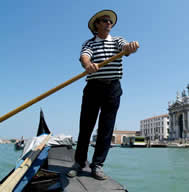 To become a gondolier, a budding apprentice must first pass stringent exams after attending courses to learn the specialist skills required. This can take 12 – 18 months to complete.
To become a gondolier, a budding apprentice must first pass stringent exams after attending courses to learn the specialist skills required. This can take 12 – 18 months to complete.
Not only is the rowing proficiency of the gondoliers examined but they must also be conversant in different languages and become a knowledgeable tour guide before sitting a final practical ‘proof of oar’ exam overseen by three ‘judge’ gondoliers.
Only then can they become a member of the coveted ‘Guild of Gondoliers’ and after all these conditions have been met, a would-be gondolier will then have to inherit or try to buy the expensive license to operate as a bona fide gondolier.
To operate as a legitimate gondolier requires a license from the Chamber of Commerce who control the only 425 licenses available.
As a gondolier retires, or quits, he can return his license to the council so it can be made available to a ‘substitute’ gondolier, one who has the necessary qualifications but does not hold a license.
As with the restrictive rules of gondola construction, so too have gondoliers’ restrictions placed upon them, mostly regarding a rigid dress code.
They must always wear black or dark blue trousers, a red and white or blue and white striped shirt and a dark jacket (if needed).
The straw hat we see many gondoliers wearing is optional.
Since 2010 female gondoliers can now also operate gondola boats
Gondoliers have traditionally been men but the first female gondolier, Giorgio Boscolo, was appointed to her new position in 2010 starting a new chapter in the chronicles of the gondola’s long history.
Although gondoliers have traditionally been men this tradition came to an end in 2010 when the first (official) female gondolier, Giorgio Boscolo was appointed her new position as the first ‘la gondoliera’ (female form of gondolier). Boscolo is the daughter of a gondolier.
Boscolo, whilst recognised as a gondoliera, is classed as a substitute or stand-in for those fully licenced gondoliers who take time off, allowing their boats to carrying on working. The takings are then shared between the gondola owner and the substitute.
Controversially, a transgender man named Alex Hai, assigned female at birth attempted to become a gondolier and commenced his apprenticeship in 1996.
However, Hai was born in Hamburg and being a non-native of Venice, encountered resistance because of the ancient traditions and institutional restrictions set by the (exclusively male) 1000-year-old Guild of Gondoliers.
Hai found himself as the defendant in a court battle initiated by the Venetian City hall who tried to prevent Hai from becoming a gondolier. In 2015 the high court in Rome ruled that he must be permitted to work as a gondolier and he now works for hotels and private hire.
How much a gondolier earn
After a gondolier has attained his license and become part of the thousand-year-old Gondoliers Guild, he, or now she, can expect to earn the equivalent of around $150,000 per year.
How to take a Gondola ride
Unlike hailing a cab, a gondola ride can be negotiated at specified stopping points along the canals.
Alternatively, arrangements can be made through tour operators.
What to expect on a Gondola ride
A gondola ride is approx. 25 – 30 minutes long and various routes are taken depending on the gondolier, otherwise, set tours are pre-determined when booking through tour operators.
Don’t expect the gondolier to sing! While it’s not uncommon to hear traditional singing on the waters of the canals, it won’t always be sung by the gondoliers.
How much a Gondola costs to ride
One source priced a 40-minute gondola ride at 80 euros for up to 6 people. Each additional 20 minutes thereafter cost 40 euros.
After 7 pm these costs rise to 100 euros and 50 euros respectively.
Gondola prices seem to be set across Venice with no variations between gondolas.
6 Other Types Of Gondolas From Around The World
A Venetian canal boat is not the only gondola that exists, the name gondola also applies to several different types of transportation and even shelving units.
So, what are gondolas like in the rest of the world?
Let’s take a look at these different gondola types now.
Gondola lift
Gondola lifts are those associated with suspended passenger compartments.
Typical gondola lifts are passenger pods such as those used on ski lifts.
Another type of gondola lift is the working platforms for window cleaners to work on outside tall buildings like skyscrapers.
Gondola lifts associated with aerial cable transport.
They are supported and propelled by cables, and are not to be confused with Aerial Tramways, as these cars are supported and propelled in a different way to gondola lifts.
Gondola lifts are attached to continually moving cables. Whereas an aerial tramway such as a sky tram, cable car or aerial tram are suspended on fixed cables and are themselves propelled forward by a moving cable attached to a motor and pulley mechanism.
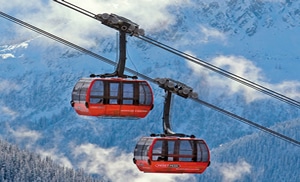
Ferris wheel gondola
A fairground Ferris wheel is an amusement ride made up usually from a steel structure consisting of a rotating ‘Giant Wheel’.
Attached to the Ferris wheel are the passenger compartments, also referred to as cabins, tubs, capsules and gondolas.
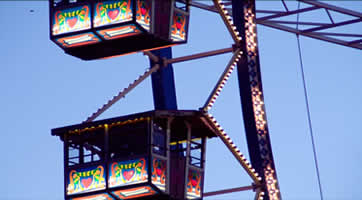
Airship gondola
The external underslung passenger and crew compartments of dirigibles and aerostats, such as those on the powered Zeppelin airships, are called gondolas.
A gondola can also refer to the underslung payload basket or capsule of an unpowered hot air balloon.
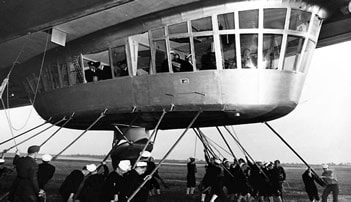
Retail shop gondola shelving
Free-standing retail display units are called gondolas and are versatile units consisting of shelving, hooks and other display features.
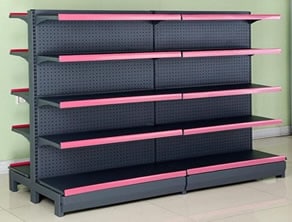
Rail carriage gondola
A railway gondola is a US term for an open top railway freight carriage used for transporting loose bulk items.
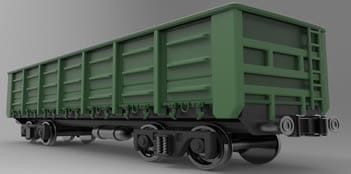
Transporter bridge gondola
A transporter bridge is a crane like structure whereby the frame carries a suspended gondola.
The gondola is the compartment for transferring freight or passengers, along the length of the structure.
